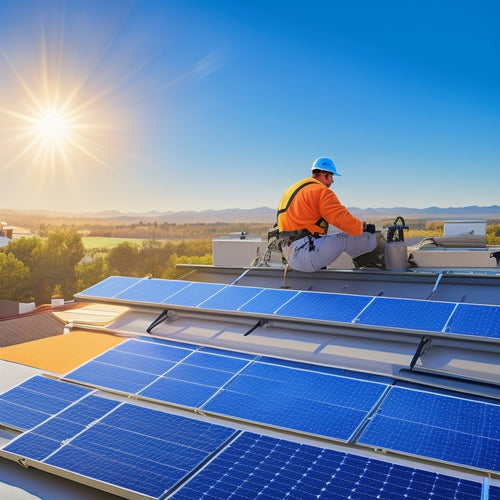
Role of Advanced Solar Technology in Renewable Energy
Share
As you investigate the role of advanced solar technology in renewable energy, you'll find that innovative designs and materials are optimizing energy output. From high-efficiency solar panels with low temperature coefficients to bifacial modules that capture energy from both sides, efficiency is on the rise. Concentrated solar power systems and advanced energy storage solutions are also essential for a reliable supply. Additionally, smart grids and predictive analytics are ensuring seamless integration and management of solar energy. As you continue to learn more about these advancements, you'll gain a deeper understanding of how they're driving the shift to a sustainable energy future, and what's next on the horizon.
Key Takeaways
- Advanced solar technology plays a crucial role in renewable energy by harnessing sunlight efficiently through innovations like bifacial panels and high-efficiency cells.
- Concentrated solar power systems utilize solar thermal technology to generate electricity, offering a reliable alternative to traditional fossil fuels.
- Energy storage and grid integration are critical components of advanced solar technology, ensuring a stable and efficient supply of renewable energy.
- Predictive analytics and real-time monitoring optimize energy yield, reduce uncertainty, and enable prompt maintenance, making solar power a viable option.
- Government incentives, technology partnerships, and declining installation costs have driven widespread adoption of advanced solar technology in the renewable energy sector.
Harnessing Solar Energy Efficiently
When it comes to utilizing solar energy efficiently, the photovoltaic (PV) system's design and installation play an indispensable role in maximizing energy output. You need to guarantee that your solar panel system is designed and installed to capture the most sunlight possible.
This is where solar panel innovations come into play. Advanced technologies like bifacial solar panels, which can absorb light from both the front and back sides, can considerably increase energy output. Additionally, using high-efficiency solar panels with lower temperature coefficients can also enhance energy production.
Proper system design and installation are vital in minimizing energy losses and guaranteeing peak energy efficiency. You should also consider factors like shading, orientation, and tilt to refine your system's performance.
Advancements in Photovoltaic Cells
Silicon wafers, the building blocks of photovoltaic cells, have undergone significant changes in recent years.
You're now witnessing the emergence of perovskite cells, which boast higher power conversion efficiency and lower production costs. Bifacial modules, capable of utilizing energy from both sides, are becoming increasingly popular.
Transparent photovoltaics, integrated into building facades, generate power while allowing light to pass through.
You're also seeing advancements in organic photovoltaics, which offer flexibility and lower costs. Tandem solar cells, combining two or more materials, are pushing the boundaries of solar cell efficiency.
Recycling technologies are being developed to recover useful materials from retired solar panels, reducing waste and environmental impact. Meanwhile, innovations in thin film technology are enhancing solar panel durability and efficiency.
Building integrated photovoltaics are becoming more prevalent, turning buildings into power-generating assets. As you investigate these advancements, you'll realize that photovoltaic cells are becoming more efficient, cost-effective, and environmentally friendly.
Concentrated Solar Power Systems
As you investigate the domain of advanced solar technology, you're likely to notice that photovoltaic cells are just one piece of the renewable energy puzzle. Concentrated Solar Power (CSP) systems are another crucial component, utilizing the sun's energy through solar thermal technology. CSP systems use mirror design to focus sunlight, generating heat for electricity production. This approach enables hybrid systems that can store energy for later use, increasing efficiency and reducing scalability challenges.
Some key aspects of CSP systems include:
- Heat collection and storage systems that enable dispatchable power generation
- Advanced mirror design and materials to maximize energy absorption
- Efficiency metrics that optimize system performance and minimize environmental impact
When deploying CSP systems, it's important to evaluate deployment strategies, maintenance solutions, and policy incentives that promote widespread adoption.
Energy Storage and Grid Integration
Your energy independence hinges on the ability to store excess energy generated by advanced solar technology. This is where energy storage and grid integration come into play. With advanced battery technology, you can store excess energy for later use, guaranteeing a reliable supply of power when you need it. This not only enhances energy resilience but also enables demand response, where you can adjust your energy usage in response to changes in the grid.
To achieve seamless grid integration, you'll need a smart grid that can manage distributed generation from solar power systems. Renewable policies and solar incentives can encourage the adoption of microgrid solutions, which provide energy equity by supplying clean energy to communities that need it most.
Solar Power Forecasting and Management
You're about to investigate the state-of-the-art techniques that facilitate accurate solar power forecasting and management.
You'll learn about advanced solar irradiance prediction tools that help optimize energy yield, as well as energy yield optimization methods that guarantee maximum performance.
Solar Irradiance Prediction Tools
Solar irradiance prediction tools have become a cornerstone of efficient solar power forecasting and management, allowing utility companies and renewable energy stakeholders to accurately anticipate and prepare for the variable output of solar farms.
By leveraging advanced solar radiation modeling and predictive analytics tools, you can better understand and predict the amount of solar energy that will be generated. This enables you to make informed decisions about energy distribution, grid management, and even energy trading.
Some key benefits of solar irradiance prediction tools include:
- Improved forecasting accuracy, reducing uncertainty and enabling more efficient energy planning
- Enhanced grid stability, as utilities can better anticipate and manage the variable output of solar farms
- Increased revenue opportunities, as accurate predictions enable more effective energy trading and sales strategies
Energy Yield Optimization Methods
By accurately predicting solar irradiance, renewable energy stakeholders can optimize energy yield through advanced forecasting and management methods. You can improve energy harvesting by integrating technology that analyzes performance and identifies opportunities to enhance system efficiency. This involves employing data analytics to fine-tune your solar power systems, ensuring they operate at peak capacity.
| Energy Yield Optimization Method | Description | Benefits |
|---|---|---|
| Machine Learning Algorithms | Analyze historical data to predict solar irradiance | Improve forecasting accuracy, reduce uncertainty |
| Real-time Performance Monitoring | Track system performance in real-time | Identify areas for improvement, optimize energy harvesting |
| Advanced Weather Forecasting | apply high-resolution weather models | Enhance short-term forecasting, optimize energy trading |
Real-time Monitoring Systems
Nearly 90% of solar power systems rely on real-time monitoring to optimize energy yield and reduce operational costs. You can't afford to be in the dark about your system's performance.
Real-time monitoring systems use data analytics and remote sensing to provide you with accurate and timely observations into your solar power generation. This enables you to identify areas of improvement, predict energy output, and make data-driven decisions to maximize your returns.
Some key features of real-time monitoring systems include:
-
Real-time data visualization: You get instant access to your system's performance data, allowing you to track energy production, identify anomalies, and respond quickly to issues.
-
Predictive analytics: Advanced algorithms analyze historical data, weather forecasts, and system performance to predict energy output, enabling you to optimize energy trading and grid stability.
-
Automated alerts and notifications: You receive timely alerts and notifications about system faults, maintenance needs, and performance anomalies, ensuring prompt action and minimizing downtime.
Cost Reduction and Market Adoption
As the renewable energy environment continues to evolve, one essential factor driving the widespread adoption of advanced solar technology is its plummeting cost. You're likely aware that installation costs have decreased dramatically over the years, making solar energy a more competitive option in the market. This reduction in cost can be attributed to various factors, including government incentives, consumer awareness, and technology partnerships.
| Factors Contributing to Cost Reduction | Description |
|---|---|
| Incentive Programs | Governments offer tax credits, grants, and rebates to encourage adoption |
| Technology Partnerships | Collaboration between companies leads to improved manufacturing efficiency and economies of scale |
| Financing Options | Innovative financing models, such as power purchase agreements, reduce upfront costs |
| Market Trends | Increasing demand drives down prices due to economies of scale |
| Government Policies | Renewable portfolio standards and net metering laws promote solar adoption |
As the cost of advanced solar technology continues to decline, you can expect to see increased market adoption. With a more competitive environment, companies are now offering innovative solutions to make solar energy more accessible to consumers.
Future of Advanced Solar Technology
Frequently, experts forecast that advanced solar technology will continue to evolve rapidly, altering the renewable energy environment in the years to come.
You can expect significant advancements in solar materials, innovative designs, and system integrations that will further reduce costs and increase efficiency.
As the industry progresses, you'll see policy implications and global trends shaping the market behavior, leading to increased consumer adoption and technology partnerships.
Some key areas to watch include:
- Research investments in emerging technologies like perovskite solar cells and bifacial panels, which could revolutionize the industry
- Sustainability initiatives focused on reducing environmental impacts, such as recycling and repurposing solar panels at the end of their life cycle
- Government policies and regulations that promote the adoption of advanced solar technology, driving market growth and competitiveness
Frequently Asked Questions
Can Solar Panels Generate Electricity During Nighttime Hours?
You wonder if solar panels can generate electricity during nighttime hours; the answer is no, but you can capture solar energy during the day and store it for nighttime energy generation through advanced solar energy storage systems.
How Do Weather Conditions Affect Solar Panel Efficiency?
You'll find that weather conditions greatly impact solar panel performance, as cloudy or foggy days reduce energy output by up to 50%, while extreme temperatures and humidity can decrease efficiency by 10-20%.
Are Solar Panels Compatible With All Roofing Materials?
Savvy solar seekers, scrutinize your roofing realities: you'll find solar panels seamlessly sync with sleek, sturdy surfaces like asphalt shingles or metal roofs, but installation considerations vary, demanding careful compatibility checks to guarantee a secure, high-performance fit.
Can Advanced Solar Technology Be Used for Water Purification?
You can utilize advanced solar technology for water purification through solar distillation, which uses heat from solar panels to evaporate and condense water, or photovoltaic purification, which powers UV systems to kill bacteria and other contaminants.
Are There Any Health Risks Associated With Solar Panel Installation?
As you venture into the world of solar power, you're wise to wonder: are there health risks lurking in the shadows of installation? Fortunately, you'll find that proper installation safety measures minimize health impacts, allowing you to capture the sun's energy with confidence.
Related Posts
-

What You Need to Know About Permits and Inspections
You need to navigate the complex landscape of permits and inspections to guarantee your project complies with local z...
-

Safety First: Why Seniors Need Advanced Vehicle Features
As you get behind the wheel, you're likely unaware that seniors are 16% more likely to be involved in a fatal car cra...
-

3 Essential Steps for Solar Electricity Installation
To guarantee a successful solar electricity installation, you'll need to follow three essential steps. First, assess ...


